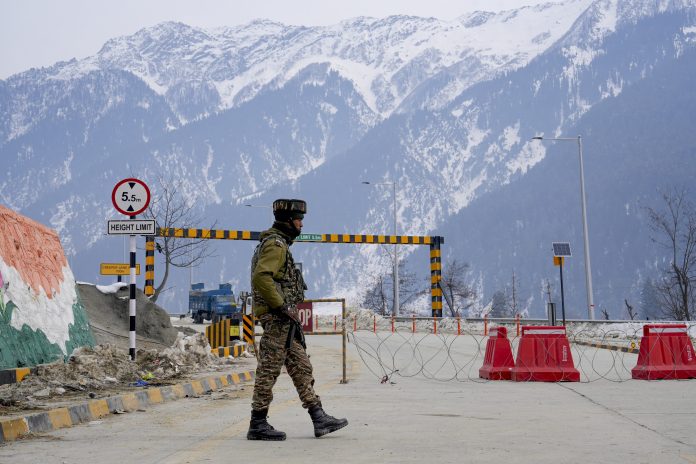One day before Prime Minister Narendra Modi visits the valley to officially open the strategically significant Z-Morh tunnel in Ganderbal district, security personnel in Kashmir stepped up their sanitization efforts and area dominance exercise on Sunday, according to officials.
To make sure that anti-national elements cannot freely move around, they claimed, security personnel have been deployed in more vulnerable regions and dozens of checkpoints have been erected at key intersections in different districts.
According to the officers, patrolling is also underway, and random checks and frisking of individuals and vehicles, including two-wheelers, have increased.
“Security has been tightened near the Z-Morh tunnel. Multi-layered security arrangements have been put in place and the PM’s security team, comprising the SPG personnel, has taken over the venue,” they said.
The prime minister is likely to address a public rally after the inauguration of the tunnel at Gagangir, the officials said, adding the venue is now off-limits for the public.
The security apparatus for Monday’s inauguration includes the Army, the Jammu and Kashmir Police, and paramilitary personnel. According to the officials, extensive area domination drills, searches, and patrols are being carried out to ensure the event runs smoothly.
Sharpshooters have been placed at strategic locations, and technical and aerial surveillance—including using drones—is also being carried out. They stated that the region is under constant surveillance.
A terrorist attack near the tunnel site in the Gagangir district earlier on October 20 of last year killed seven people, including a local doctor.
The Srinagar-Leh national highway will be closed from Saturday to Monday by the authorities “to facilitate maintenance work by road maintenance agencies and due to icy road conditions caused by inclement weather.”
Nonetheless, it is generally believed that the prime minister’s presence has caused the artery road connecting Jammu and Kashmir and Ladakh to be closed.
The strategically important 6.5-km Z-Morh tunnel, which was constructed on the Srinagar-Leh National Highway at a cost of Rs 2,400 crore, would be a significant step towards ensuring that the Ladakh area is reachable by road all year round. The project was finished last year, with work having started in May 2015.
In February 2024, the tunnel underwent a soft opening.
The tunnel is essential for both connecting the newest Union Territory to the rest of the nation and meeting the nation’s defense needs in the Ladakh region.
At 8,650 feet above sea level, the Z-Morh tunnel is a two-lane road tunnel with an emergency escape channel that is 7.5 meters wide.
The tunnel would facilitate summer travel to Ladakh and guarantee smooth connectivity between Gagangir and Sonamarg.
The Z-Morh tunnel, in addition to the Zojila tunnel now under construction, will guarantee continuous access for both military and civilian traffic to the Baltal and Ladakh regions.
The “engineering marvel” is a game changer for the area, according to the National Highways and Infrastructure Development Corporation Limited (NHIDCL), which is in charge of the project.
“The Sonamarg Tunnel in Jammu and Kashmir is a game-changer for the region, offering more than just a connection between Gagangir and Sonamarg. This engineering marvel is poised to unlock the full potential of the region’s trade and tourism sectors,” the NHIDCL said on X.
According to the statement, the tunnel is outfitted with state-of-the-art technologies that offer users seamless communication and real-time information. In addition to improving traffic, this cutting-edge infrastructure will establish a new benchmark for regional road connection.
It would ensure smooth NH-1 communication between Srinagar and Ladakh by reducing the route length from 49 km to 43 km and increasing vehicle speed from 30 km/hr to 70 km/hr, in conjunction with the Zojila Tunnel, which is scheduled for completion by 2028.
According to the government, this improved connectivity will promote economic growth, improve defense logistics, and foster sociocultural cohesion throughout Jammu & Kashmir and Ladakh.




